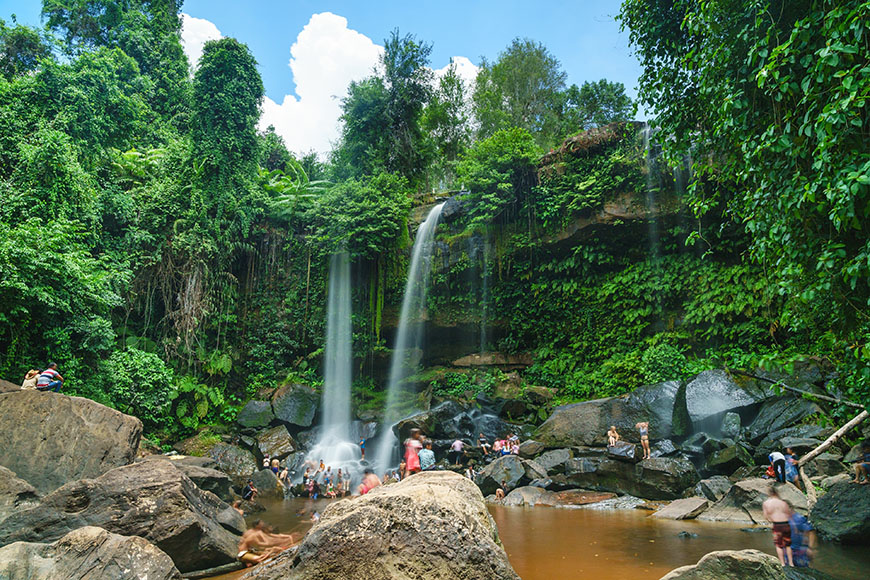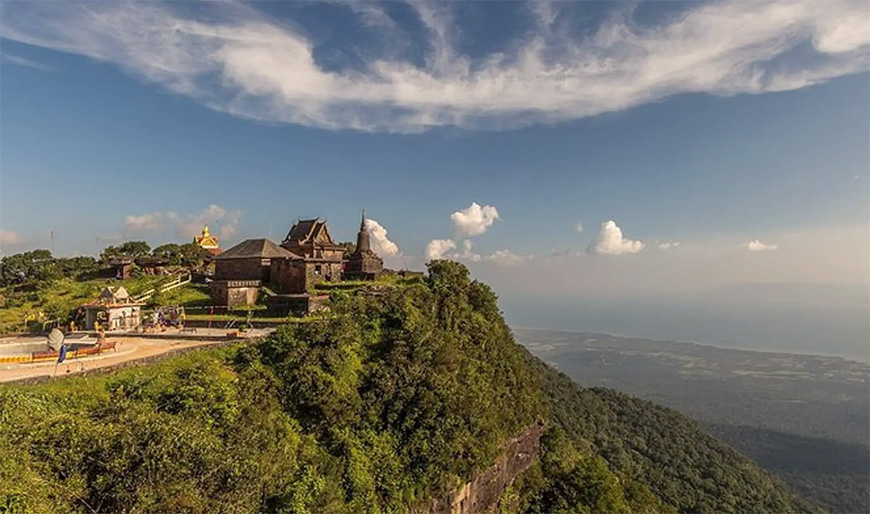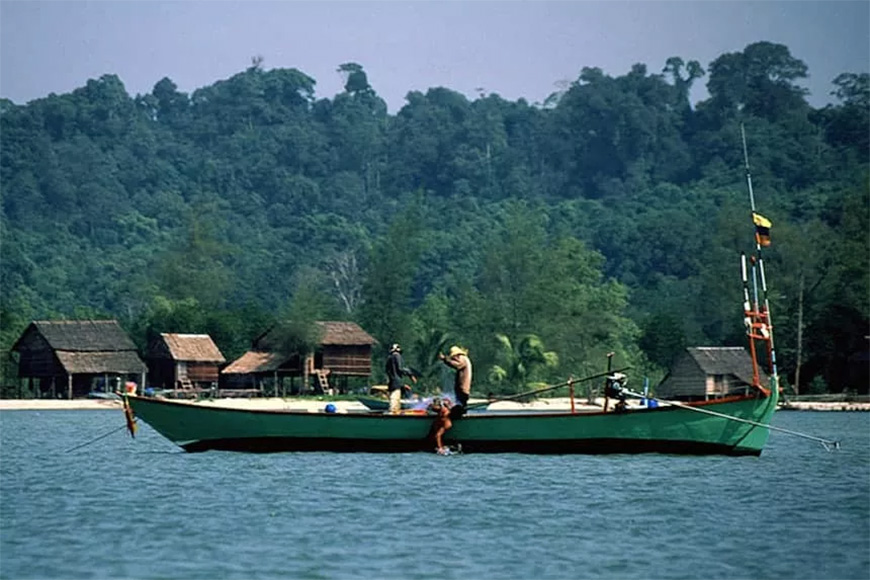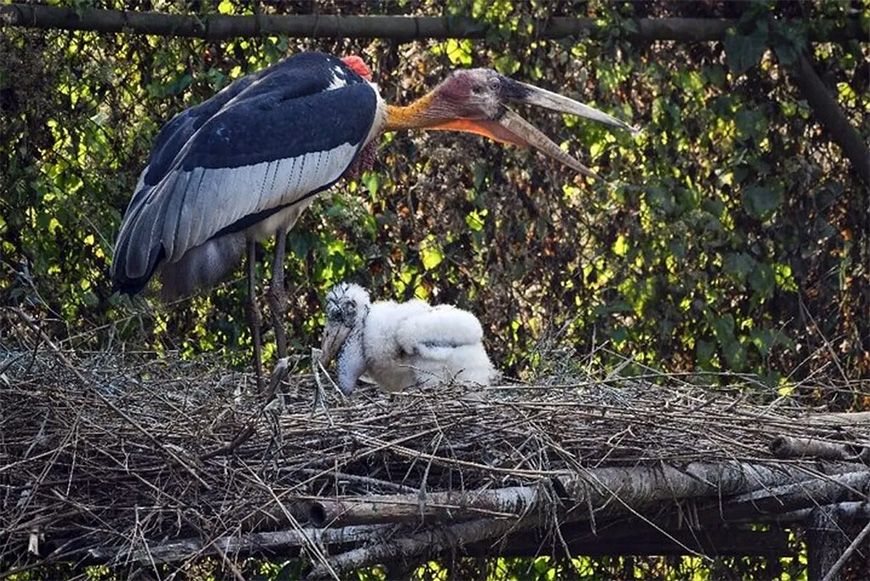Cambodia, often celebrated for the splendor of Angkor Wat and the richness of its history, also holds natural treasures of striking beauty. More than 7.5 million hectares (41% of the territory) are protected areas, harboring rich biodiversity and diverse landscapes, offering a welcome escape for travelers seeking nature and adventure.
To help you plan your trip in 2025, here is an overview of the five most remarkable natural reserves in Cambodia, selected for their biodiversity, unique landscapes, and the activities they offer.
 The Phnom Kulen Waterfall. a refreshing spot - Internet
The Phnom Kulen Waterfall. a refreshing spot - InternetPhnom Kulen National Park
Phnom Kulen National Park, located about 50 kilometers from Siem Reap, is a revered site in Cambodia, steeped in history and spirituality. In 802 AD, King Jayavarman II proclaimed Cambodia's independence here, marking the birth of the Khmer Empire.
Among its main attractions is the River of a Thousand Lingas (Kbal Spean), a sacred site where 1000 lingas sculptures were carved into the riverbed in homage to the Hindu god Shiva. Another natural wonder, the Phnom Kulen Waterfall offers a refreshing swimming spot with a calmer upper section for families and a more impressive lower part. Interestingly, this waterfall briefly appears in the movie Lara Croft: Tomb Raider. The park also houses the Preah Ang Thom Pagoda, which houses a giant reclining Buddha, considered the largest in Cambodia. For lovers of ancient sculptures, Srah Damrei (Elephant Pond) features stone-carved animals, including elephants and lions, accessible on foot.
The best time to visit Phnom Kulen in 2025 is likely during the dry season, from November to April, which offers ideal weather conditions for hiking and swimming.
The park is accessible from Siem Reap by car or van (approximately 1.5 to 2 hours), or even by tuk-tuk for the lower part of the mountain. The entrance fee is $20 per person. It is important to note that the road to the summit is one-way and access is limited before 11 am. Respectful attire is recommended, especially for swimming and temple visits.
 Preah Monivong Bokor National Park and its French colonial ruins - Internet
Preah Monivong Bokor National Park and its French colonial ruins - InternetPreah Monivong Bokor National Park
Located in the lush Damrei Mountains in southwestern Cambodia, Preah Monivong Bokor National Park offers a stark contrast to the heat of the plains. This vast park, spanning over 1,500 square kilometers, is known for its misty landscapes and cooler climate.
Its main attraction is the abandoned Bokor Hill mountain resort, a remnant of the French colonial era with ruins of a casino, church, and hotels. Built in the 1920s as a retreat for the French, the resort was abandoned after the death of King Monivong in 1941 and during the Khmer Rouge regime, before being partially rehabilitated. The park offers spectacular panoramic views, including of the Gulf of Thailand. It also features the Popokvil Waterfall, more impressive during the intermediate seasons, and the imposing Lok Yeay Mao statue. The park was designated as an ASEAN Heritage Park in 2003, highlighting its regional ecological importance.
The fauna is diverse, including Asian black bears, Malayan sun bears, clouded leopards, red-shanked doucs, and over 300 bird species, including various hornbills. In the past, elephants and tigers also roamed these lands. The vegetation ranges from dipterocarp forests to deciduous forests, tropical evergreen forests, and mangroves.
Activities include hiking on trails through pristine nature, wildlife and bird watching, and exploring the historical sites of Bokor Hill. Trails ranging from two to eight hours are available.
The best time to visit the park in 2025 is during the dry season, from December to March, to enjoy the most pleasant weather and clear views. The intermediate seasons (April-May, September-November) are also feasible, especially to admire the Popokvil Waterfall at its peak towards the end of the rainy season.
The park is easily accessible by car (rental or with a driver) from Phnom Penh (about 4 hours) or Kampot (about 1 hour). Renting a motorcycle in Kampot is another option, although caution is advised due to the mountainous terrain. Organized tours are also available from Kampot. As of the writing of this article (March 2025), entry to the park is free.
 Kep National Park, between land and sea - Internet
Kep National Park, between land and sea - InternetKep National Park
Located in the province of Kep, on the southern coast of Cambodia, Kep National Park offers a unique experience where the emerald of the mountains meets the lapis lazuli of the sea.
The park is known for its well-maintained and relatively easy hiking trails, including the 8 km mountain circuit and the picturesque "Stairway to Heaven." Remarkably, it is one of the few national parks in Cambodia where hiking does not require a guide. The trails offer breathtaking views of the Bokor Mountains, the Vietnamese island of Phu Quoc, and the coastline of Kep. An unusual stop within the park is the Led Zep Cafe, a popular spot for relaxation and dining. Founded by a Frenchman, Christian Debinut, who also mapped the park's trails, this cafe has become a local institution. Other points of interest include the Little Buddha Pagoda (Phnom Kep), a monastery, and the Sunset Rock, offering spectacular views.
Fauna includes monkeys, various bird species, and many butterflies, particularly visible from April to October. The vegetation is lush and tropical throughout the year.
The best time to visit Kep National Park in 2025 is during the dry and cool season, from November to April, which offers the most pleasant weather conditions for hiking and other outdoor activities.
The main entrance to the park is behind the Veranda Resort, near the main road in Kep. It is easy to rent a bicycle or motorcycle to explore the park independently (around 5to5 to 5to10 per day). Tuk-tuks and taxis are also available from downtown Kep. The entrance fee is modest, usually around 1to1 to 1to2 per person.
 Ream National Park,the Cambodia's first national park - Internet
Ream National Park,the Cambodia's first national park - InternetReam National Park
Located in the province of Sihanoukville, Ream National Park offers a spectacular landscape where lush jungle meets pristine beaches, encompassing a diversity of ecosystems from mainland forests to mangroves, islands, and coral reefs.
Ream was Cambodia's first national park, established in 1993 to preserve threatened wildlife and forests along the Gulf of Thailand coast. The Prek Teuk Sap River winds through the park before flowing into the ocean, separating two distinct hills. The idyllic islands of Koh Thmei and Koh Seh invite exploration and tranquility. Magnificent white sandy beaches line the park's coastline, offering perfect spots for relaxation.
Marine life is abundant, with the possibility of spotting dolphins, sea turtles, and a variety of colorful fish in the park's waters and coral reefs. Koh Thmei Island is a paradise for birdwatchers, hosting over 150 bird species, including the rare Brahminy Kite. In the mangrove forests, monkeys, playful otters, and brightly colored kingfishers can be observed. It is even possible to spot whales off the park's coast.
Recreational activities include boat excursions through the mangrove forests, snorkeling, or kayaking. Hiking trails wind through the lush jungle, offering encounters with diverse flora and fauna. Relaxing on the beautiful beaches is also a popular activity.
The best time to visit Ream National Park in 2025 is during the dry season, from November to April, which offers mostly sunny and dry weather, ideal for all outdoor activities. The months from November to January are particularly pleasant with cooler temperatures, perfect for hiking and boat excursions.
The park is located about 18 kilometers from downtown Sihanoukville, making it easily accessible by taxi, tuk-tuk, motorcycle, or through an organized tour. The journey typically takes about half an hour. There is usually no entrance fee for the park itself, but a small parking fee (around $1 USD) may apply. Fees may be charged for certain activities such as boat excursions or guided hikes.
 Prek Toal Bird Sanctuary, a paradise for birdwatching - Internet
Prek Toal Bird Sanctuary, a paradise for birdwatching - InternetPrek Toal Bird Sanctuary (Tonle Sap Biosphere Reserve)
Nestled in the heart of the vast Tonle Sap Biosphere Reserve, the largest freshwater lake in Southeast Asia, the Prek Toal Bird Sanctuary is globally recognized as the most important breeding site in Southeast Asia for threatened large waterbirds.
This sanctuary is home to an incredible diversity of rare and endangered bird species, with over 120 to 150 different species recorded, including the black-headed ibis, painted stork, greater and lesser adjutants, spot-billed pelican, and milky stork. The region is characterized by a freshwater swamp forest, providing a crucial habitat for these birds.
The main activity is bird watching on guided boat excursions through the sanctuary. Some tours also include visits to the fascinating floating villages of Tonle Sap and crocodile and fish farms, adding cultural and wildlife observation elements to the experience.
The best time to visit Prek Toal for bird watching is during the dry season, from December to May, when large flocks of migratory birds gather in the sanctuary to breed. However, it is important to note that the water level tends to drop significantly after February, which can make access to some of the best observation sites more challenging. The period from December to early February is considered the high season, with the highest concentration of birds.
Access to Prek Toal is mainly by boat from the Chong Kneas pier near Siem Reap, with a journey of about two hours. The Prek Toal Environmental Research Station provides information on local flora and fauna and offers basic accommodation for those who wish to enjoy the best observation times at sunrise and sunset. An entrance fee for bird watching is generally required, around $20 to 25 USD per person, often including a guided boat tour. These fees contribute to promoting responsible tourism in Cambodia and support the conservation of the region, particularly through education for children and villagers.
Your Cambodian nature adventure in 2025 awaits you
Beyond its cultural richness, Cambodia offers impressive natural diversity. In 2025, set out to discover Cambodia's natural treasures. Hiking, bird watching, colonial vestiges, diverse ecosystems... a unique adventure awaits you!